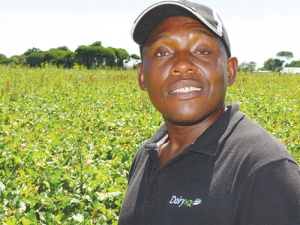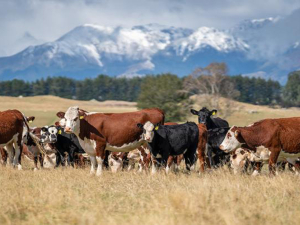About 30 dairy farmers attended the discussion group, held in a typical rural seminar room – the end of a dairy shed, shaded against another hot day (28oC) in Horowhenua.
The aim of such a day, says DairyNZ team leader for the lower North Island, James Muwunganirwa, is to find out where everyone is in respect of covers, production and the like, and to discuss ways of getting through the difficult times.
Next on the agenda is a talk by host farmer Mike Keeling, who contract milks on his parents' farm, then a farm walk. That allows the farmers to look at the property and suggest to Keeling ways of dealing with some of his challenges.
Muwunganirwa sets the scene with a general rundown on the state of farms in the lower North Island. He says most farms are in good physical shape because the dry is not as severe as most thought it would be by now. Good rain fell in January, in some cases 100-150ml, he says.
"On the East Coast things are looking reasonably good. Hawkes Bay has probably had a little more rain than we have on this side of the ranges. Normally some of those guys up there would have had restrictions that would have kicked in at this time of the year, but generally they haven't had restrictions yet."
He says most farmers have aggressively culled their herds because of the low milk price so there is more pasture available and fewer supplements being used. Most farmers are cautiously optimistic that they have enough feed to see them through to autumn.
Muwunganirwa says he has noticed in his area this season that production is slightly behind what it was this time last year, but he points out that with fewer supplements being used, the milk being produced is 'profitable' milk.
Now the cows are looking in reasonable condition and crops look good with healthy yields.
Farmers seem focused on maintaining cow condition rather than squeezing every last drop of milk out of them at the expense of having them at peak condition for calving.
But while things are arguably ticking over ok onfarm, morale is taking a hit, Muwunganirwa says. Some farmers are now 'under the pump', pressured by the low milk price. Though it's hard to generalise because debt and equity levels vary from farm to farm, it's very tight for most people.
"The average owner-operator in the lower North Island will get $3.90 in cash income in this 12 month season.
"At a break-even milk price of, say, $5.40, most people will be about $1.50 out of pocket."
He says lower order and 50/50 sharemilkers will find it challenging and he expects more financial pain. However, like many he's hoping prices will pick up long term.
"There needs to be a focus on strategies for the long term and the realisation that the volatility cycle is something we have to live with. We need to work out how we can make our dairy farm businesses resilient and cope with the highs and lows," he says.
Hanging in there
The farmers generally reported good covers – mostly in the 2200-2400 range.
Most reported milk production down about 4%, some were 14% down. But a few were up, the highest by 18%. Most said they had reduced cow numbers, this by and large accounting for the drop in milk production.
The words 'hanging in there' best described the mood of the group as they talked about their positions and how best to cope with a situation beyond their control.
Troy Hobson, a director of Tahamata, a local Maori incorporation running a dairy farm near Keelings, says it's been a good growing season and there is still grass around. Normally there wouldn't be any at this time of year and people would be irrigating and feeding out, he says.
"From that side it's looking pretty good," he says.
But the good news stops there, and Hobson with extensive experience in dairying, says farmers need to look critically at their businesses and not dismiss any option out of hand.
"For example, you have to look seriously at the guaranteed milk price, at least hedging some of your risk. You have to look hard at how your capital is working, including who you're supplying and whether the money tied up in shares is worth it. You also need to look at other non-core assets that are not generating a return."
Malcolm Wallace, from Otaki, says there is a limit to how much a person can trim their budget. He also claims the taxation system works against farmers. Wallace says he's just breaking even on the present payout.
"But we're not drawing wages; not many people work for free these days do they? Farmers are getting pretty worried. The payout forecast went up a bit and that gave a bit of hope, but it's come back again and it creates a lot of concern," he says.
As the discussion draws to a close Muwunganirwa writes on a whiteboard the suggestions by farmers on how to cut costs. These include taking special care with machinery to reduce repairs and maintenance and looking at the best deals for electricity to run irrigation and the dairy shed.
All-rounder loves his job
Mike Keeling is the third generation of Keelings to run the 132ha effective farm and 109ha support block.
The 320 cows will hopefully produce around 105,000kgMS this season. The farm has moved to once-a-day milking to try to improve profitability in the long term and cope with predicted lower payouts.
There are many challenges facing Keeling, who was born on the farm, spent a year at Lincoln and then worked on dairy farms in Canterbury before heading to Australia.
He's been back on this farm for just two years and is grappling with farm infrastructure which needs upgrading and succession planning; he has four sisters.
On the farm, the in-calf rate has been poor and he's working on a strategy to fix that. He's moving from split calving to OAD and possibly changing the breed of cow.
"We are definitely looking at changing the breed and finding something that can tolerate OAD. Definitely a Kiwi cross. There is room for improvement in the production.
"Probably going from a split herd to seasonal is going to lift production by 10% at least but going to an OAD herd will see this drop back a bit and we may possibly have to increase our cow numbers for that. The farm itself is quite challenging because no paddock is the same size and we have about 15 different soil types on the farm."
Keeling hopes moving to OAD will help. He expects lower power bills and animal health costs and a better lifestyle with more time to devote to thinking up new strategies to improve the farm.
This year he has grown turnips and the yield is impressively high and admired by the discussion group members who toured the farm.
He says he's working with his father to reduce costs and minimise buying in feed. His goal is to keep the farm a system 2 and be as self contained as possible.
Despite the challenges, Keeling says he loves dairy farming. "I'm a jack of all trades and like to do a lot of things; dairy farming caters for that."


















